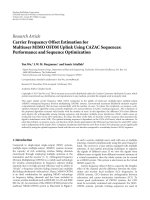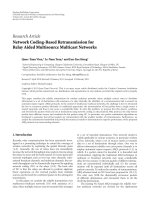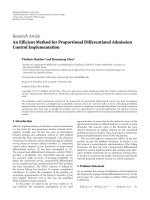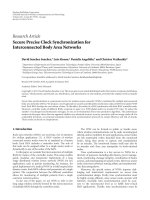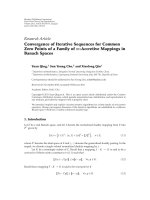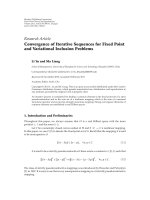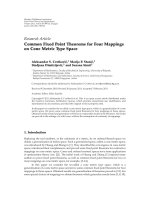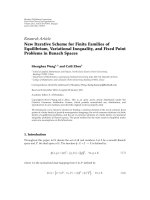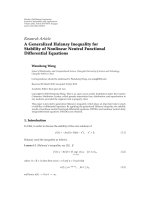Báo cáo hóa học: " Research Article New Dilated LMI Characterization for the Multiobjective Full-Order Dynamic Output Feedback " ppt
Bạn đang xem bản rút gọn của tài liệu. Xem và tải ngay bản đầy đủ của tài liệu tại đây (602.22 KB, 21 trang )
Hindawi Publishing Corporation
Journal of Inequalities and Applications
Volume 2010, Article ID 608374, 21 pages
doi:10.1155/2010/608374
Research Article
New Dilated LMI Characterization for
the Multiobjective Full-Order Dynamic Output
Feedback Synthesis Problem
Jalel Zrida1, 2 and Kamel Dabboussi1, 2
1
Ecole Sup´ rieure des Sciences et Techniques de Tunis, 5 Taha Hussein Boulevard,
e
BP 56, Tunis 1008, Tunisia
2
Unit´ de Recherche SICISI, Ecole Sup´ rieure des Sciences et Techniques de Tunis,
e
e
5 Taha Hussein Boulevard, BP 56, Tunis 1008, Tunisia
Correspondence should be addressed to Kamel Dabboussi, dabboussi
Received 23 April 2010; Revised 17 August 2010; Accepted 17 September 2010
Academic Editor: Kok Teo
Copyright q 2010 J. Zrida and K. Dabboussi. This is an open access article distributed under
the Creative Commons Attribution License, which permits unrestricted use, distribution, and
reproduction in any medium, provided the original work is properly cited.
This paper introduces new dilated LMI conditions for continuous-time linear systems which
not only characterize stability and H2 performance specifications, but also, H∞ performance
specifications. These new conditions offer, in addition to new analysis tools, synthesis procedures
that have the advantages of keeping the controller parameters independent of the Lyapunov
matrix and offering supplementary degrees of freedom. The impact of such advantages is great
on the multiobjective full-order dynamic output feedback control problem as the obtained dilated
LMI conditions always encompass the standard ones. It follows that much less conservatism
is possible in comparison to the currently used standard LMI based synthesis procedures. A
numerical simulation, based on an empirically abridged search procedure, is presented and shows
the advantage of the proposed synthesis methods.
1. Introduction
The impact of linear matrix inequalities on the systems community has been so great that
it dramatically changed forever the usually utilized tools for analyzing and synthesizing
control systems. The standard LMI conditions benefited greatly from breakthrough advances
in convex optimization theory and offered new solutions to many analysis and synthesis
problems 1–3 . When necessary and sufficient LMI conditions are not possible, as it is
the case for the static output control 4, 5 , the multi-objective control 6–8 , or the robust
control 9–12 problems, sufficient conditions were provided, but were known to be overly
conservative. Some dilated versions of LMI conditions have first appeared in the literature
2
Journal of Inequalities and Applications
in 13 , wherein some robust dilated LMI conditions were proposed for some class of
matrices. Since then, a flurry of results has been proposed in both the continuous-time
6, 7, 10, 14–17 and the discrete-time systems 5, 14, 18–20 . These conditions offer, though,
no particular advantages for monoobjective and precisely known systems, but were found
to greatly reduce conservatism in the multi-objective 6–8, 19 and the robust control
problems 9, 10, 14–16, 18, 19 . In this respect, an interesting extension for the utilization
of these dilated LMI conditions as in, e.g., 21–23 provided solutions to the problem
of robust root-clustering analysis in some nonconnected regions with respect to polytopic
and norm-bounded uncertainties. Generally, the main feature of these LMI conditions, in
their dilated versions, consists in the introduction of an instrumental variable giving a
suitable structure, from the synthesis viewpoint, in which the controller parameterization is
completely independent from the Lyapunov matrix. A particular difficulty though with these
proposed dilated versions in the continuous-time case is the absence of dilated H∞ conditions
as it is visible in 6, 15 .
This paper introduces new dilated LMIs conditions for the design of full-order
dynamic output feedback controllers in continuous-time linear systems, which not only
characterize stability and H2 performance specifications, but also, H∞ performance
specifications as well. Similarly to the existing dilated versions, these new dilated LMI
conditions carry the same properties wherein an instrumental variable is introduced giving
a suitable structure in which the controller parameterization is completely independent from
the Lyapunov matrix. In addition, scalar parameters are also introduced, within these dilated
LMI, to provide a supplementary degree of freedom whose impact is to further reduce, in
a significant way, the conservatism in sufficient standard LMI conditions. It is also shown,
in this paper, that the obtained dilated LMI conditions always encompass the standard
ones. As a result, the conservatism which results whenever the standard LMI conditions are
used is expected to considerably reduce in many cases. This paper focuses on the multiobjective full-order dynamic output feedback controller design in continuous-time linear
systems for which the constraining necessity of using a single Lyapunov matrix to test all
the objectives and all the channels, which constitutes a major source of conservatism, is no
longer a necessity as a different Lyapunov matrix is separately searched for every objective
and for every channel. It is shown, in this paper, that despite constraining the instrumental
variable, the new dilated LMI conditions are, at worst, as good as the standard ones, and,
generally, much less conservative than the standard LMI conditions. The proposed solution
is quite interesting, despite an inevitable increase in the number of decision variables in
the involved LMIs and a multivariable search procedure that could be abridged through
empirical observations. A numerical simulation is presented and shows the advantage of
the proposed synthesis method.
2. Background
Consider the linear time-invariant continuous-time and input-free system
x t
˙
Ax t
Bw t ,
2.1
zt
Cx t
Dw t ,
Journal of Inequalities and Applications
3
where the state vector x t ∈ Rn , the perturbation vector w t ∈ Rm , and the performance
vector z t ∈ Rp . All the matrices A, B, C, and D have appropriate dimensions. Let Hwz s
A B
C sI − A −1 B D be the system transfer matrix from input w to output z. The
C D
following two lemmas are well known see, e.g., 1, 3 and provide necessary and sufficient
conditions for System 2.1 to be asymptotically stable under an H2 performance constraint
and a H∞ performance constraint, respectively. These standard results will be extensively
used in this paper.
Lemma 2.1. System 2.1 with D 0 is asymptotically stable and Hwz s
there exist symmetric matrices XH2 ∈ Rn×n and W ∈ Rm×m such that
2
2
< γH2 if and only if
Trace W < γH2 ,
XH2 B
∗
> 0,
W
Sym{AXH2 } XH2 CT
∗
−I
2.2
< 0.
Lemma 2.2. System 2.1 is asymptotically stable and Hwz s
a symmetric matrixXH∞ > 0 in Rn×n such that
2
∞
< γH∞ if and only if there exists
⎡
⎤
Sym{AXH∞ } XH∞ CT
B
⎢
⎥
⎢
∗
−I
D ⎥ < 0.
⎣
⎦
∗
∗
−γH∞ I
2.3
3. Multiobjective Control Synthesis
Consider the continuous-time time-invariant linear system with input
x
˙
z
Ax
Cz x
Bw w
Dzw w
Cy x
y
Bu u,
Dzu u,
3.1
Dyw w,
where the state vector x t ∈ Rn , the perturbation vector t ∈ Rm , the input command vector
u t ∈ Rq , the performance vector z t ∈ Rp , and the controlled output vector y t ∈ Rr , and
all the matrices A, Bw , Bu , Cz , Dzw , Dzu , Cy , and Dyw have the appropriate dimensions. In the
dynamic output feedback case, the control law is given by the state equations
η
˙
Λη
u
Γy,
Φη.
3.2
4
Journal of Inequalities and Applications
As this controller is supposed to be of a full order n, Λ ∈ Rn×n , Γ ∈ Rn×r , and Φ ∈ Rq×n . The
closed-loop system is then described by the augmented state equations
x
˙
η
˙
z
ACl
CCl
x
BCl w,
η
3.3
x
DCl w,
η
where
A
Bu Φ
ΓCy
ACl
Λ
CCl
∈ R2n×2n
,
Bw
BCl
Cz Dzu Φ ∈ Rp×2n ,
ΓDyw
DCl
∈ R2n×m ,
3.4
Dzw ∈ Rp×m .
The closed loop system transfer matrix from input w to output z then becomes
⎡
Hwz s
ACl BCl
CCl DCl
A
Bu Φ
Bw
⎤
⎢
⎥
⎢ ΓCy
Λ ΓDyw ⎥.
⎣
⎦
Cz Dzu Φ Dzw
3.5
It is supposed that this system is of a multichannel type meaning that the perturbation vector
w is partitioned into a given number say I of block components,
w t
T
T
w1 t | · · · | wiT t | · · · | wI t
T
∈ Rm ;
I
wi t ∈ Rmi ;
mi
m,
3.6
i 1
and the performance vector z is partitioned into a given number say J of block components,
zt
zT t | · · · | zT t | · · · | zT t
j
1
J
T
∈ Rp ;
zj t ∈ Rpj ;
J
pj
p.
3.7
j 1
It is supposed that some performance specifications are defined with respect to a particular
channel ij a path relating input component wi to output component zj or a combination
of channels. It is also supposed that, for a given control law strategy, these performance
specifications can always be expressed in terms of an H2 and/or a H∞ transfer matrix norm
Ej Hwz s Fi , where the matrices Ej and
of the corresponding channel, namely, Hwi zj s
Fi are set to select the desired input/output channel from the system closed-loop transfer
matrix Hwz s . In fact, Ej is a J-block row matrix of dimension pj × p such that only the jth
block is nonzero and is the identity matrix in Rpj . Similarly, Fi is an I-block column vector of
dimension m × mi such that only the ith block is nonzero and is the identity matrix in Rmi . The
Journal of Inequalities and Applications
5
problem of the multi-objective controller synthesis is to construct a controller that stabilizes
the closed loop system and, simultaneously, achieves all the prescribed specifications. It is
easy to see that, for each channel ij, the closed loop transfer matrix is given by
⎡
Hwi zj s
A
⎢
Ej ⎢ ΓCy
⎣
Cz
Bu Φ
Bw
⎡
⎤
A
Bu Φ
Bw F i
⎤
⎢
⎥
⎢ ΓCy
Λ
ΓDyw Fi ⎥.
⎣
⎦
Ej Cz Ej Dzu Φ Ej Dzw Fi
⎥
ΓDyw ⎥Fi
⎦
Dzu Φ Dzw
Λ
3.8
On the channel basis, the closed-loop system is then described by
x
˙
η
˙
zj
x
ACl,ij
CCl,ij
BCl,ij wi ,
η
x
η
3.9
DCl,ij wi ,
where
ACl
ACl,ij
CCl,ij
A
Bu Φ
ΓCy
Λ
∈ R2n×2n ,
BCl,ij
Ej Cz Ej Dzu Φ ∈ Rp×2n ,
Ej CCl
DCl,ij
BCl Fi
Bw F i
ΓDyw Fi
Ej DCl Fi
∈ R2n×m ,
3.10
Ej Dzw Fi ∈ Rp×m .
The dynamic output feedback synthesis multi-objective problem consists of looking for a
dynamic controller that stabilizes the closed loop system and, in the same time, achieves the
desired H2 and/or H∞ performance specifications for every single system channel. More
specifically, the dynamic output feedback synthesis multi-objective problem aims at making
System 3.1 possess the following propriety.
Propriety P
System 3.1 is stabilizable by a dynamic output feedback law 3.2 such that, for every
channel ij, either or both of the following two conditions hold:
i
Hwi zj
2
2
ii
Hwi zj
2
∞
< γH2,ij with Ej Dzw Fi
0;
< γH∞,ij .
Theorem 3.1 the standard sufficient conditions . If there exist symmetric matrices X1 ∈ Rn×n
and X−1 ∈ Rn×n , general matrices Λ1 ∈ Rn×n , Γ1 ∈ Rn×r , and Φ1 ∈ Rq×n and, for every channel ij,
there exists a symmetric matrix Wij ∈ Rm×m such that either or both of the following two conditions
6
Journal of Inequalities and Applications
are satisfied:
i
StdH2
Trace Wij < γH2,ij ,
⎤
⎡
X−1 I X−1 Bw Fi Γ1 Dyw Fi
⎥
⎢
⎥ > 0,
⎢ ∗ X1
Bw F i
⎦
⎣
∗ ∗
Wij
⎡
Sym X−1 A
⎢
⎢
∗
⎣
∗
ii
AT
Γ1 Cy
T T
Cz Ej
Λ1
Sym{AX1
3.11
⎤
⎥
T
T
ΦT Dzu Ej ⎥ < 0;
1
⎦
T T
Bu Φ1 } X1 Cz Ej
∗
−I
StdH∞
X−1 I
I
⎡
Sym X−1 A
⎢
⎢
∗
⎢
⎢
⎢
∗
⎣
∗
AT
Γ1 Cy
X1
> 0,
T T
Cz Ej
Λ1
Sym{AX1
T T
Bu Φ1 } X1 Cz Ej
T
T
ΦT Dzu Ej
1
X−1 Bw Fi
Γ1 Dyw Fi
Bw F i
∗
−I
Ej Dzw Fi
∗
∗
⎤
⎥
⎥
⎥
⎥ < 0,
⎥
⎦
−γH∞,ij I
3.12
then, Propriety P holds, and furthermore, a set of the controller parameters defined in
3.2 is given by
Λ
−1
−T
−T
−1
−X−2 X−1 AX1 X2 − ΓCy X1 X2 − X−2 X−1 Bu Φ
Γ
−1
X−2 Γ1 ,
Φ
−1
−T
X−2 Λ1 X2 ,
3.13
−T
Φ1 X2 ,
where the nonsingular matrices X2 and X−2 are obtained via the equation
X1 X−1
T
X2 X−2
I.
Proof. If either or both of conditions StdH2 and StdH∞ are satisfied, let X
and let T
X−1 I
T
X−2 0
3.14
X1
X2
−T
T
T
X2 −X2 X−1 X−2
be a nonsingular transformation matrix, with X2 and X−2 selected from
Journal of Inequalities and Applications
7
3.14 among infinitely many possibilities via the singular value decomposition of I −X1 X−1 .
In view of 3.13 and 3.14 , the following useful identities are easily derived:
X−1 I
T T XT
I
X−1 A
T T ACl XT
X1
,
Γ1 Cy
Λ1
A
AX1
Bu Φ1
,
3.15
T T BCl,ij
CCl,ij XT
X−1 Bw Fi
T T BCl Fi
Γ1 Dyw Fi
,
Bw F i
Ej CCl XT
Ej Cz Ej Cz X1
Ej Dzu Φ1 .
As either or both of conditions StdH2 and StdH∞ are satisfied, by the congruence
lemma applied to each LMI and in view of the identities listed just above, either or both of
the following conditions are also satisfied, respectively,
i
⎡
X−1 I
T −T 0 ⎢
⎢ I
0 I ⎣
∗
T −T 0
I
0
⎡
T
−T
0
X1
Γ1 Dyw Fi
Bw F i
Wij
T T XT T T BCl,ij
∗
Wij
Sym X−1 A
0 ⎢
⎢
I ⎣
⎤
⎥ T −1 0
⎥
⎦ 0 I
T −1 0
I
X BCl,ij
Γ1 Cy
∗
Wij
AT
0
> 0,
Λ1
∗ Sym{AX1
I
Sym T T ACl XT
∗
T
T T XCCl,ij
T T
Bu Φ1 } X1 Cz Ej
−I
T −1 0
0
I
⎤
T T
Cz Ej
∗
T −T 0
0
X−1 Bw Fi
⎥ T −1 0
T
T
ΦT Dzu Ej ⎥
1
⎦ 0 I
−I
T
Sym{ACl X} XCCl,ij
∗
−I
< 0;
3.16
8
Journal of Inequalities and Applications
ii
T −T
X−1 I
I
X1
T −1
X > 0;
3.17
⎡ −T
⎤
T
0 0
⎢
⎥
⎣ 0 I 0⎦
0
⎡
⎢
⎢
⎢
×⎢
⎢
⎣
0 I
Sym X−1 A
AT
Γ1 Cy
∗
T T
Cz Ej
Λ1
Sym{AX1
T T
Bu Φ1 } X1 Cz Ej
∗
⎡ −1
⎤
T
0 0
⎢
⎥
× ⎢ 0 I 0⎥
⎣
⎦
0 0 I
∗
∗
T
T
ΦT Dzu Ej
1
−I
∗
⎡ −T
⎤⎡
T
0 0 Sym T T ACl XT
⎢
⎥⎢
⎢ 0 I 0⎥⎢
∗
⎣
⎦⎣
0 0 I
∗
⎡
T
Sym{ACl X} XCCl,ij
⎢
∗
−I
⎣
X−1 Bw Fi
BCl,ij
∗
T
T T XCCl,ij
−I
∗
Γ1 Dyw Fi
Bw F i
Ej Dzw Fi
⎤
⎥
⎥
⎥
⎥
⎥
⎦
−γH∞,ij I
⎤
⎤⎡ −1
T
T T BCl,ij
0 0
⎥
⎥⎢
DCl,ij ⎥⎢ 0 I 0⎥
⎦
⎦⎣
0 0 I
−γH∞,ij I
⎤
⎥
DCl,ij ⎦ < 0.
−γH∞,ij I
3.18
According to Lemmas 2.1 and 2.2, these are precisely the sufficient standard LMI conditions,
expressed on a channel basis, for Propriety P to hold.
Theorem 3.1 provides sufficient conditions for the existence of a single multi-objective
dynamic output controller in terms of LMI conditions in which common Lyapunov matrices
are enforced for convexity. This is known to produce, in general, overly conservative results.
The following theorem attempts at reducing the effect of this limitation.
Theorem 3.2 the dilated sufficient conditions . If there exist general matrices M ∈ Rn×n , G1 ∈
Rn×n , G−1 ∈ Rn×n , Λ2 , Γ2 , and Φ2 and for every channel ij, for some scalars αH2,ij > 0 and αH∞,ij > 0,
there exist symmetric matrices Vij ∈ Rmi ×mi , N1,H2,ij ∈ Rn×n , Y1,H2,ij ∈ Rn×n , N1,H∞,ij ∈ Rn×n ,
Y1,H∞,ij ∈ Rn×n , general matrices N2,H2,ij ∈ Rn×n and N2,H∞,ij ∈ Rn×n such that either or both of the
following two conditions are satisfied:
i
DilH2
Trace Vij < γH2,ij ,
⎡
⎤
N1,H2,ij N2,H2,ij GT Bw Fi Γ2 Dyw Fi
−1
⎢
⎥
Y1,H2,ij
Bw F i
⎣ ∗
⎦ > 0,
∗
∗
Vij
Journal of Inequalities and Applications
⎡
T T
αH2,ij Sym GT A Γ2 Cy
αH2,ij Λ2 AT
αH2,ij Cz Ej
−1
⎢
⎢
⎢
T
T T
T
⎢
∗
αH2,ij Sym{AG1 Bu Φ2 } αH2,ij GT Cz Ej ΦT Dzu Ej
2
1
⎢
⎢
⎢
⎢
∗
∗
−I
⎢
⎢
⎢
∗
∗
∗
⎣
∗
∗
∗
GT A
−1
N1,H2,ij
T
N2,H2,ij
Γ2 Cy − αH2,ij G−1
N2,H2,ij
A − αH2,ij MT
Y1,H2,ij
Ej Cz
−Sym{G−1 }
∗
9
⎤
Λ2 − αH2,ij I
⎥
⎥
Bu Φ2 − αH2,ij GT ⎥
1 ⎥
⎥
⎥
⎥ < 0;
Ej Cz G1 Ej Dzu Φ2
⎥
⎥
⎥
⎥
−I − M
⎦
−Sym{G1 }
AG1
3.19
ii
⎡
⎢
⎢
⎢
⎢
⎢
⎢
⎢
⎢
⎢
⎢
⎢
⎢
⎣
DilH∞
αH∞,ij Sym GT A
−1
Γ2 Cy
∗
αH∞,ij Λ2
T T
αH∞,ij Cz Ej
AT
αH∞,ij Sym{AG1
T T
Bu Φ2 } αH∞,ij GT Cz Ej
1
∗
∗
−I
∗
∗
∗
∗
∗
∗
∗
∗
T
T
ΦT Dzu Ej
2
∗
GT Bw Fi
−1
Γ2 Dyw Fi
N1,H∞,ij
GT A
−1
Γ2 Cy − αH∞,ij G−1
Bw F i
T
N2,H∞,ij
A − αH∞,ij MT
N2,H∞,ij
Λ2 − αH∞,ij I
Y1,H∞,ij
AG1
Bu Φ2 − αH∞,ij GT
1
Ej Dzw Fi
Ej Cz
Ej Cz G1
Ej Dzu Φ2
−γH∞,ij I
0
0
∗
−Sym{G−1 }
−I − M
∗
∗
⎤
⎥
⎥
⎥
⎥
⎥
⎥
⎥
⎥
⎥
⎥
⎥ < 0.
⎥
⎥
⎥
⎥
⎥
⎥
⎥
⎥
⎦
−Sym{G1 }
3.20
10
Journal of Inequalities and Applications
Then, Propriety P holds, and furthermore, a set of the controller parameters defined in 3.2
is given by
Λ
−G−T GT AG1 G−1 − G−T GT Bu Φ − ΓCy G1 G−1
−3 −1
3
−3 −1
3
Γ
G−T Γ2 ,
−3
Φ
G−T Λ2 G−1 ,
−3
3
Φ2 G−1 ,
3
3.21
where the nonsingular matrices G3 and G−3 are obtained via the equation
GT G1
−1
M
Proof. If either or both of conditions
G1 I−G1 G−1 G−1
−3
G3
−G3 G−1 G−1
−3
G−1 I
and let T
GT G3 .
−3
DilH2
3.22
and
are satisfied, let G
DilH∞
be a nonsingular transformation matrix with G3
G−3 0
and G−3 selected from 3.22 among infinitely many possibilities via the singular value
decomposition of M − GT G1 . In view of 3.21 and 3.22 , the following useful identities
−1
are easily derived:
GT M
−1
T
T GT
T
T ACl GT
I
GT A
−1
G1
,
Γ2 Cy
A
Λ2
AG1
Bu Φ2
,
3.23
T T BCl,ij
CCl,ij GT
T T BCl Fi
Ej CCl GT
GT A
−1
Γ2 Cy
A
Λ2
AG1
Ej Cz Ej Cz X1
Bu Φ2
,
Ej Dzu Φ2 .
On the other hand, let us introduce
YH2,ij
T −T
N1,H2,ij N2,H2,ij
∗
Y1,H2,ij
T −1 ,
YH∞,ij
T −T
N1,H∞,ij N2,H∞,ij
∗
Y1,H∞,ij
T −1 .
3.24
As either or both of conditions DilH2 and DilH∞ are satisfied, by the congruence
Lemma applied to each LMI and in view of the identities listed just above, either or both of
the following conditions are also satisfied, respectively.
Journal of Inequalities and Applications
11
i
⎡
T −T 0 ⎢
⎢
0 I ⎣
∗
Y1,H2,ij
Vij
T T YH2,ij T T T BCl,ij
I
Γ2 Dyw Fi
Bw F i
∗
T −T 0
0
N2,H2,ij GT Bw Fi
−1
N1,H2,ij
∗
Vij
T −1 0
0
⎤
⎥ T −1 0
⎥
⎦ 0 I
YH2,ij BCl,ij
I
∗
Vij
> 0,
⎡ −T
⎤
T
0 0
⎢
⎥
⎢ 0 I 0 ⎥
⎣
⎦
−T
0 0 T
⎡
⎢
⎢
⎢
⎢
⎢
×⎢
⎢
⎢
⎢
⎣
αH2,ij Sym GT A
−1
Γ2 Cy
∗
T T
αH2,ij Cz Ej
AT
αH2,ij Λ2
αH2,ij Sym{AG1
T T
Bu Φ2 } αH2,ij GT Cz Ej
1
∗ ∗
∗
∗ ∗
N1,H2,ij
−I
∗ ∗
T
T
ΦT Dzu Ej
2
∗
GT A
−1
T
N2,H2,ij
Γ2 Cy − αH2,ij G−1
A − αH2,ij MT
N2,H2,ij
Y1,H2,ij
Ej Cz
−Sym{G−1 }
Λ2 − αH2,ij I
⎤
⎥
Bu Φ2 − αH2,ij GT ⎥
1 ⎥
⎥
⎥
Ej Cz G1 Ej Dzu Φ2
⎥
⎥
⎥
−I − M
⎦
AG1
∗
−Sym{G1 }
⎡ −1
⎤
T
0 0
⎢
⎥
×⎢ 0 I 0 ⎥
⎣
⎦
0 0 T −1
⎡ −T
⎤⎡
T
αH2,ij Sym T T ACl GT
0 0
⎢
⎥⎢
⎢ 0 I 0 ⎥⎢
0
⎣
⎦⎣
−T
0 0 T
0
⎡ −1
⎤
T
0 0
⎢
⎥
×⎢ 0 I 0 ⎥
⎣
⎦
−1
0 0 T
T
αH2,ij T T GT CCl,ij T T YH2,ij
ACl G − αH2,ij GT T
−I
CCl,ij GT
0
−T T Sym{G}T
⎡
T
αH2,ij Sym{ACl G} αH2,ij GT CCl,ij
⎢
⎢
0
−I
⎣
0
0
YH2,ij
ACl G − αH2,ij GT
CCl,ij G
⎤
⎥
⎥
⎦
⎤
⎥
⎥ < 0;
⎦
−Sym{G}
3.25
12
Journal of Inequalities and Applications
ii
⎡ −T
T
⎢
⎢ 0
⎢
⎢ 0
⎣
0
⎡
⎢
⎢
⎢
⎢
⎢
⎢
×⎢
⎢
⎢
⎢
⎢
⎢
⎣
0 0
0
⎤
⎥
0 ⎥
⎥
0 ⎥
⎦
I 0
0 I
0 0 T −T
αH∞,ij Sym GT A
−1
∗
Γ2 Cy
T T
αH∞,ij Cz Ej
AT
αH∞,ij Λ2
αH∞,ij Sym{AG1
T T
Bu Φ2 } αH∞,ij GT Cz Ej
1
∗
∗
−I
∗
∗
∗
∗
∗
∗
∗
∗
GT Bw Fi Γ2 Dyw Fi N1,H∞,ij GT A Γ2 Cy − αH∞,ij G−1
−1
−1
T
N2,H∞,ij A − αH∞,ij MT
Bw F i
Ej Dzw Fi
N2,H∞,ij Λ2 − αH∞,ij I
0
∗
−Sym{G−1 }
0
∗
0
0
0
⎥
⎥
Bu Φ2−αH∞,ij GT ⎥
1 ⎥
⎥
⎥
⎥
Ej Cz G1 Ej Dzu Φ2
⎥
⎥
⎥
0
⎥
⎥
⎥
−I− M
⎦
−Sym{G1 }
⎤
⎥
⎥
⎥
⎥
⎦
0 0 T −1
⎤
0 0 0
⎥
I 0 0 ⎥
⎥
⎥
0 I 0 ⎦
0 0 T −T
⎡ −T
T
⎢
⎢ 0
⎢
⎢
⎣ 0
0
⎡
T
αH∞,ij T T Sym{ACl G}T αH∞,ij T T GT CCl,ij
⎢
⎢
∗
−I
⎢
× ⎢
⎢
∗
∗
⎣
∗
⎡ −1
T
0 0
⎢
⎢ 0 I 0
×⎢ 0 0 I
⎢
⎣
0
⎤
Y1,H∞,ij AG1
Ej Cz
−γH∞,ij I
∗
⎡ −1
T
0 0
⎢
⎢ 0 I 0
×⎢ 0 0 I
⎢
⎣
T
T
ΦT Dzu Ej
2
0
0
0
0 0 T −1
∗
⎤
⎥
⎥
⎥
⎥
⎦
T T BCl,ij T T YH∞,ij
ACl G − αH∞,ij GT T
DCl,ij
CCl,ij GT
−γH∞,ij I
0
∗
−T T Sym{G}T
⎤
⎥
⎥
⎥
⎥
⎥
⎦
Journal of Inequalities and Applications
⎡
T
αH∞,ij Sym{ACl G} αH∞,ij GT CCl,ij
⎢
⎢
ef22∗
−I
⎢
⎢
⎢
∗
∗
⎣
∗
13
BCl,ij
ACl G − αH∞,ij GT
Y H∞,ij
DCl,ij
CCl,ij G
−γH∞,ij I
0
∗
⎤
⎥
⎥
⎥
⎥ < 0.
⎥
⎦
−Sym{G}
∗
3.26
To summarize, we have proven that if either or both conditions DilH2 and DilH∞
are satisfied, then either or both of the following conditions are also satisfied:
i
Trace Vij < γH2,ij ,
YH2,ij BCl,ij
∗
Vij
⎡
T
αH2,ij Sym{ACl G} αH2,ij GT CCl,ij
⎢
⎢
0
−I
⎣
0
0
> 0,
3.27
YH2,ij
ACl G − αH2,ij GT
CCl,ij G
⎤
⎥
⎥ < 0;
⎦
−Sym{G}
ii
⎡
T
αH∞,ij Sym{ACl G} αH∞,ij GT CCl,ij
⎢
⎢
∗
−I
⎢
⎢
⎢
∗
∗
⎣
∗
BCl,ij
YH∞,ij
ACl G − αH∞,ij GT
CCl,ij G
−γH∞,ij I
0
∗
∗
DCl,ij
⎤
⎥
⎥
⎥
⎥ < 0.
⎥
⎦
−Sym{G}
3.28
The third LMI of the first item condition is equivalent to
⎡
0
0
⎢
⎢∗ − I
⎣
∗ ∗
YH2,ij
⎤
⎥
0 ⎥
⎦
0
⎫
⎧⎡
⎤
⎪
⎪ ACl
⎪
⎪
⎬
⎨⎢
⎥
⎢CCl,ij ⎥G αH2,ij I 0 I
Sym ⎣
<0
⎦
⎪
⎪
⎪
⎪
⎭
⎩
−I
3.29
14
Journal of Inequalities and Applications
which, according to the elimination lemma 3 , leads to
⎡
0
YH2,ij
0
YH2,ij
I 0 ACl ⎢
⎢∗ − I
0 I CCl,ij ⎣
∗ ∗
⎡
0
⎤⎡
0
I 0 −αH2,ij I ⎢
⎢∗ − I
⎣
0 I
0
∗ ∗
I
∗
⎤
⎥⎢
⎥
I ⎥ < 0,
0 ⎥⎢ 0
⎦⎣
⎦
T
AT CCl,ij
0
Cl
⎤⎡
I
⎥⎢
0
0 ⎥⎢
⎦⎣
−αH2,ij
0
3.30
⎤
0
⎥
I ⎥ < 0.
⎦
I 0
T
Sym{ACl YH2,ij } YH2,ij CCl,ij
The two previous LMIs are equivalent to
−2αH2,ij YH2,ij 0
0
∗
−I
<
0 and
< 0, that is, for any αH2,ij > 0, YH2,ij > 0.
−I
Similarly, the LMI of the second item condition is equivalent to
⎡
0 0
BCl,ij
⎢
⎢∗ −I DCl,ij
⎢
⎢
⎢∗ ∗ −γH∞,ij I
⎣
∗ ∗
YH∞,ij
∗
0
0
⎤
⎥
⎥
⎥
⎥
⎥
⎦
0
⎧⎡
⎫
⎤
⎪ ACl
⎪
⎪
⎪
⎪⎢
⎪
⎪
⎪
⎥
⎪⎢
⎪
⎨ CCl,ij ⎥
⎬
⎥
⎢
Sym ⎢
< 0.
⎥G αH∞,ij I 0 0 I
⎪⎢ 0 ⎥
⎪
⎪⎣
⎪
⎪
⎪
⎦
⎪
⎪
⎪
⎪
⎩
⎭
−I
3.31
According to the Elimination lemma, this leads to
⎡
⎤ 0
I 0 0 ACl ⎢
⎥⎢∗
⎢
⎢0 I 0 CCl,ij ⎥⎢
⎦⎢∗
⎣
⎢
⎣
0 0 I
0
∗
⎡
⎡
⎤ 0
⎡
I 0 0 −αH∞,ij I ⎢
⎥⎢∗
⎢
⎥⎢
⎢0 I 0
0
⎦⎢∗
⎣
⎢
⎣
0 0 I
0
∗
0
BCl,ij
YH∞,ij
−I
DCl,ij
0
∗ −γH∞,ij I
0
∗
0
∗
⎤⎡
BCl,ij
YH∞,ij
−I
DCl,ij
0
0
∗
0
∗
0
⎤
0
⎥
0⎥
⎥
⎥ < 0,
I⎥
⎦
⎥⎢
⎥⎢ 0
I
⎥⎢
⎥⎢
⎥⎢ 0
0
⎦⎣
T
T
ACl CCl,ij 0
0
∗ −γH∞,ij I
I
⎤⎡
I
0 0
⎤
3.32
⎥⎢
⎥
⎥⎢
0
I 0⎥
⎥⎢
⎥
⎥⎢
⎥ < 0.
⎥⎢
0
0 I⎥
⎦⎣
⎦
−αH∞,ij I 0 0
The previous two matrix inequalities are equivalent to
⎡
Sym ACl YH∞,ij
⎢
⎢
∗
⎣
∗
T
YH∞,ij CCl,ij
−I
∗
BCl,ij
⎤
⎥
DCl,ij ⎥ < 0,
⎦
−γH∞,ij I
⎡
⎤
−2αH∞,ij YH∞,ij 0
BCl,ij
⎢
⎥
⎢
∗
−I DCl,ij ⎥ < 0.
⎣
⎦
∗
∗ −γH∞,ij I
3.33
Journal of Inequalities and Applications
15
Table 1: Simulation results, with GC s representing the LMI produced full-order dynamic output feedback
controller.
Synthesis method
Problem
Standard/controller
γH2 ,γH∞
H2 and H∞
GC s
Dilated/controller
Two-dimensional search procedure
171.7, 149.9 with
γH2 , γH∞
αH∞ 6 and αH2 11
292.27,194.67
−16.4s2 − 96.7s − 67.1
3
s 12.3s2 50.7s 73.1
GC s
−15.4s2 − 80.2s − 6.2
11.2s2 40s 46.8
s3
One-dimensional search procedure
199.71, 147.56
γH2 , γH∞
with α αH∞ αH2 4
GC s
Decision variable number
30
−17s2 − 91.5s − 23.1
s3 11.8s2 44s 51
Decision variable number
87
Via the Schur lemma, the latter inequality is equivalent to YH∞,ij > 0 and
−I
DCl,ij
∗ −γH∞,ij I
Clearly, as
−I
DCl,ij
∗ −γH∞,ij I
α−1
H∞,ij
2
⎡
0
⎤
−1
× ⎣ T ⎦YH∞,ij 0 BCl,ij < 0.
BCl,ij
3.34
< 0, there always exists a sufficiently large αH∞,ij > 0 which
satisfies this LMI. According to Lemmas 2.1 and 2.2, these are precisely the sufficient standard
LMI conditions, expressed on a channel basis, for Propriety P to hold.
Theorem 3.2 also provides sufficient conditions for the existence of a single multiobjective dynamic output controller in terms of LMI conditions in which the constraint of a
common Lyapunov matrix is no longer needed. Convexity is rather insured by constraining
the instrumental variables G to be common. This is known to produce, in general, less
conservative results than those obtained with the standard conditions of Theorem 3.1.
Reducing further this conservatism is also possible through the positive scalar parameters
αH2,ij and αH∞,ij . A simple multidimensional search procedure can be carried out in the
space of these parameters in order to obtain the values of these parameters for which
LMI 3.19 and/or LMI 3.20 are feasible and produce the best multi-objective dynamic
output controller with optimal performance levels. This multidimensional search procedure
can, however, be overly expensive if the number of channel gets larger. A solution to this
rather annoying limitation will be proposed in the next section. Yet, the important results of
Theorem 3.2 constitute a significant contribution to the multi-objective control problem.
Next, the important question on whether or not the standard conditions could possibly
be recovered by the dilated conditions will be addressed in the following section.
16
Journal of Inequalities and Applications
4. Recovery Condition
In the following theorem, it will be shown that our proposed dilated LMI conditions for
the design of multiobjective full-order dynamic output feedback controllers do indeed
encompass the standard conditions. This situation will be of great importance, as it will
guarantee that conservatism will be almost always reduced. Similar results do exist in the
literature in both the discrete-time 19 and the continuous-time case 6, 7 . The continuoustime results were, however, strictly concerned with the multi-channel H2 synthesis problem
and only in 7 that the recovery of the standard approach is proven. In view of this, the
following theorem extends the discrete-time results to the continuous-time case. This point
constitutes the major contribution of this paper.
Theorem 4.1. For, the multi-objective dynamic output feedback synthesis problem, if the standard
LMI conditions of Theorem 3.1 are satisfied and achieve, with a given controller, the upper bounds
S
S
γH2,ij and γH∞,ij , then the dilated inequality conditions of Theorem 3.2 are also satisfied with the same
S
S
D
D
controller and with the upper bounds γH2,ij ≤ γH2,ij and γH∞,ij ≤ γH∞,ij .
Proof. If the standard LMI conditions of Theorem 3.1 are satisfied for a given controller and
S
S
achieve, for every channel, the upper bounds γH2,ij and γH∞,ij , then there exist symmetric
matrices X and Wij such that
S
Trace Wij < γH2,ij ,
X BCl,ij
∗
Wij
> 0,
T
Sym{ACl X} XCCl,ij
∗
−I
4.1
<0
and/or
X > 0,
⎡
⎤
T
Sym{ACl X} XCCl,ij BCl,ij
⎢
⎥
⎢
∗
−I
DCl,ij ⎥ < 0.
⎣
⎦
S
∗
∗
−γH∞,ij I
4.2
Let us prove that these standard LMI conditions imply that the dilated inequality conditions
of Theorem 3.2 are also satisfied with the same controller. When expressed in terms of
Journal of Inequalities and Applications
17
the system closed-loop parameters, the right-hand sides of the dilated LMI conditions of
Theorem 3.2 take the following form:
Trace Vij ,
YH2,ij BCl,ij
∗
,
Vij
⎤
⎡
T
αH2,ij Sym{ACl G} αH2,ij GT CCl,ij YH2,ij ACl G − αH2,ij GT
⎥
⎢
⎥
⎢
∗
−I
CCl,ij G
⎦
⎣
∗
∗
−Sym{G}
4.3
and/or
⎡
⎤
T
αH∞,ij Sym{ACl G} αH∞,ij GT CCl,ij BCl,ij YH∞,ij ACl G − αH∞,ij GT
⎢
⎥
⎢
⎥
∗
−I
DCl,ij
CCl,ij G
⎢
⎥
⎢
⎥.
⎢
⎥
∗
∗
−γH∞,ij I
0
⎣
⎦
∗
∗
∗
−Sym{G}
Let, in these matrices, YH2,ij
D
γH∞,ij
S
γH∞,ij and G
YH∞,ij
X, Vij
Wij , αH2,ij
αH∞,ij
α−1 X, these right-hand sides become
D
α, γH2,ij
4.4
S
γH2,ij ,
Trace Wij ,
X BCl,ij
∗
,
Wij
⎡
⎤
T
Sym{ACl X} XCCl,ij α−1 ACl X
⎢
⎥
⎢
∗
− I α−1 CCl,ij X ⎥.
⎣
⎦
−1
∗
∗
−2α X
4.5
and/or
⎡
⎤
T
Sym{ACl X} XCCl,ij BCl,ij
α−1 ACl X
⎢
⎥
⎢
∗
−I
DCl,ij α−1 CCl,ij X ⎥
⎢
⎥
⎢
⎥.
S
⎢
⎥
0
∗
∗
−γH∞,ij I
⎣
⎦
∗
∗
∗
−2α−1 X
4.6
18
Journal of Inequalities and Applications
Let us prove, for these four matrices above, that the second matrix is positive definite
while the third and/or the fourth matrices are both negative definite. Clearly, the standard
conditions imply that
S
Trace Wij < γH2,ij ,
X BCl Fi
∗
Wij
> 0.
4.7
By virtue of the Schur complement lemma, the third matrix and/or the fourth matrix
will be negative definite if and only if X > 0,
T T
Sym{ACl X} XCCl Ej
∗
−I
ACl
ACl
α−1
X
×
2
Ej CCl
Ej CCl
T
< 0,
4.8
and/or
⎡
⎤
T T
Sym{ACl X} XCCl Ej
BCl Fi
⎢
⎥
⎢
∗
−I
Ej DCl Fi ⎥
⎣
⎦
S
∗
∗
−γH∞,ij I
⎡
ACl
⎤ ⎡
ACl
⎤T
⎥ ⎢
⎥
α−1 ⎢
× ⎢Ej CCl ⎥X ⎢Ej CCl ⎥ < 0.
⎣
⎦ ⎣
⎦
2
0
0
4.9
As, from the standard H2 and H∞ conditions,
Sym{ACl X}
T T
XCCl Ej
∗
−I
< 0,
⎡
⎤
T T
Sym{ACl X} XCCl Ej
BCl Fi
⎢
⎥
⎢
∗
−I
Ej DCl Fi ⎥ < 0,
⎣
⎦
S
∗
∗
−γH∞,ij I
4.10
there always exists an α > 0 which achieves, simultaneously, these two conditions. As a result,
the dilated inequality conditions of Theorem 3.2 are also satisfied. This proves that the dilated
LMI multi-objective conditions always encompass the standard ones. Clearly, this means that
S
D
D
the dilated-based approach yields upper bounds that are always γH2,ij ≤ γH2,ij and γH∞,ij ≤
S
γH∞,ij .
Theorem 4.1 has proven that the dilated LMI conditions of Theorem 3.2 do indeed
encompass the standard ones of Theorem 3.1. The multidimensional search procedure carried
out in the space of the scalars αH2,ij , αH∞,ij being exhaustive, up to a given discretization
step that could be made as small as needed, does indeed cover every region, and in particular,
the region where the standard conditions are recovered and which is defined by α αH2,ij
αH∞,ij , where α is greater than a minimum value αmin defined by the two LMIs just in the
proof above. In practice, the value of αmin can be easily computed through a simple one
dimensional line search procedure over these two LMIs.
On the other hand, at the light of the results of Theorem 3.2, a controller which achieves
the best global performance level can be obtained through the minimization of the global
objective function i,j γH∞,ij γH2,ij . Under this setting, it appears that optimality is always
achieved very close to where all the αH2,ij and all the αH∞,ij coincide. This purely empirical
Journal of Inequalities and Applications
19
rule, observed with many examples we have tried, fits nicely to where the recovery of the
standard conditions can be proved. In order to achieve optimality, it is then reasonable to
abridge the costly multi-dimensional search procedure to a much cheaper one-dimensional
αH∞,ij
α for all channels. In this way, this proposed simple
search in the line αH2,ij
line search procedure not only provides a near optimal solution, but achieves the recovery
condition which guarantees that this solution is, at least, as good as the one provided by the
standard conditions.
5. An Example
Consider the LTI unstable third-order plant
⎡ ⎤
x1
˙
⎢ ⎥
⎢x2 ⎥
⎣˙ ⎦
x3
˙
z1
z2
⎡
⎤⎡ ⎤ ⎡ ⎤
⎡ ⎤
0
x1
1
⎥⎢ ⎥ ⎢ ⎥
⎢ ⎥
0 ⎥⎢x2 ⎥ ⎢0⎥w ⎢1⎥u,
⎦⎣ ⎦ ⎣ ⎦
⎣ ⎦
0
−5 x3
1
⎡
⎤
⎡ ⎤
1 0 0
0
⎢
⎥⎡ ⎤ ⎢ ⎥
⎢0 0 0⎥ x1
⎢1⎥
⎢
⎥
⎢ ⎥
⎢
⎥⎢ ⎥ ⎢ ⎥
⎢0 1 0⎥⎢x2 ⎥ ⎢0⎥u,
⎢
⎥⎣ ⎦ ⎢ ⎥
⎢
⎥
⎢ ⎥
⎢0 0 1⎥ x3
⎢0⎥
⎣
⎦
⎣ ⎦
0 0 0
1
⎡ ⎤
x1
⎢ ⎥
1 0 ⎢x2 ⎥ 2w.
⎣ ⎦
x3
0 10 2
⎢
⎢−1 1
⎣
0 2
⎡ ⎤
x1
⎢ ⎥
⎢u⎥
⎢ ⎥
⎢ ⎥
⎢x2 ⎥
⎢ ⎥
⎢ ⎥
⎢x3 ⎥
⎣ ⎦
u
y
0
5.1
The system is supposed to be consisting of two channels. Channel 1 connects the perturbation
vector w to the performance component z1 , while Channel 2 connects the perturbation vector
w to the performance component z2 . The objective here is to find a stabilizing full-order
i.e., a third order dynamic output feedback controller which achieves simultaneously and
optimally the performance specifications Hwz2 2 < γH2 and Hwz1 2 < γH∞ , relatively to
2
∞
Channel 2 and Channel 1, respectively. Optimality is here defined as the minimization of
γH2 γH∞ , giving equal importance to the two channels. The use of the dilated LMI conditions
can be carried out through a search procedure in the plane αH2 , αH∞ . Figure 1 is a threeγH∞ in that plane. This figure clearly
dimensional plot which depicts the waveform of γH2
αH∞
α. In this
shows that optimality is achieved close to the direction where αH2
example, it is found that the minimum value of α which guarantees recovery is αmin 680.
The abridged search procedure along the line αH2 αH∞ α produced a near optimal global
199.71 and γH∞
147.56 when α αH2
αH∞
4. Clearly, in this
performance of γH2
example, improvement is being made in the region below αmin 680 where recovery is not
necessarily there. Table 1 lists the simulation results obtained with the sufficient standard LMI
conditions of Theorem 3.1 and with the sufficient dilated LMI conditions of Theorem 3.2.
The advantage of using the dilated rather than the standard LMI conditions is quite
visible with this example. Indeed, around a 30% improvement on H2 and a 25% improvement
20
Journal of Inequalities and Applications
3000
γH∞ + γH2
2500
2000
1500
1000
500
0
20
15
αH
10
2
5
0
0
Figure 1: 3D-plot of the waveform γH2
5
10
αH∞
15
20
γH∞ in the plane αH2 , αH∞ .
on H∞ performance levels were possible. However, this improvement comes at the expense
of almost tripling the number of decision variables involved in the proposed dilated LMI
conditions see Table 1 .
6. Conclusion
This paper has presented new dilated LMI conditions for the design of multiobjective fullorder dynamic output controllers in continuous-time systems that are able to cope not only
with stability analysis and H2 performance specifications, but also, with H∞ performance
specifications as well. The paper developed new controller synthesis procedures which offer
no particular advantage for precisely known monoobjective systems, but significantly reduce
conservatism in the multi-objective control problem, as the main property of these new
dilated LMI conditions, besides the fact thatthey allow a complete independence between
the standard Lyapunov matrix and the controller parametersis that they always encompass
the standard ones. A numerical simulation is presented which supports these claims. The
extension of these results to other control issues such as the robust controller, model
predictive controller, and filter design problems is rather straightforward and yet very useful.
References
1 S. Boyd, L. El Ghaoui, E. Feron, and V. Balakrishnan, Linear Matrix Inequalities in System and Control
Theory, vol. 15 of SIAM Studies in Applied Mathematics, SIAM, Philadelphia, Pa, USA, 1994.
2 Y. Nesterov and A. Nemirovskii, Interior-Point Polynomial Algorithms in Convex Programming, vol. 13
of SIAM Studies in Applied Mathematics, SIAM, Philadelphia, Pa, USA, 1994.
3 R. E. Skelton, T. Iwazaki, and G. Grigoriadis, A Unified Approach to Linear Control Design, Taylor and
Francis Series in Systems and Control, Taylor and Francis, London, UK, 1997.
4 C. A. R. Crusius and A. Trofino, “Sufficient LMI conditions for output feedback control problems,”
IEEE Transactions on Automatic Control, vol. 44, no. 5, pp. 1053–1057, 1999.
5 K. H. Lee, J. H. Lee, and W. H. Kwon, “Sufficient LMI conditions for H∞ output feedback stabilization
of linear discrete-time systems,” IEEE Transactions on Automatic Control, vol. 51, no. 4, pp. 675–680,
2006.
Journal of Inequalities and Applications
21
6 P. Apkarian, H. D. Tuan, and J. Bernussou, “Continuous-time analysis, eigenstructure assignment,
and H2 synthesis with enhanced linear matrix inequalities LMI characterizations,” IEEE Transactions
on Automatic Control, vol. 46, no. 12, pp. 1941–1946, 2001.
7 Y. Ebihara and T. Hagiwara, “New dilated LMI characterizations for continuous-time multiobjective
controller synthesis,” Automatica, vol. 40, no. 11, pp. 2003–2009, 2004.
8 C. Scherer, P. Gahinet, and M. Chilali, “Multiobjective output-feedback control via LMI optimization,”
IEEE Transactions on Automatic Control, vol. 42, no. 7, pp. 896–911, 1997.
9 M. Dettori and C. W. Scherer, “New robust stability and performance conditions based on parameter
dependent multipliers,” in Proceedings of the 36th IEEE Conference on Decision and Control (CDC ’00),
vol. 5, pp. 4187–4192, 2000.
10 Y. Ebihara and T. Hagiwara, “A dilated LMI approach to robust performance analysis of linear timeinvariant uncertain systems,” Automatica, vol. 41, no. 11, pp. 1933–1941, 2005.
11 E. Feron, P. Apkarian, and P. Gahinet, “Analysis and synthesis of robust control systems via
parameter-dependent Lyapunov functions,” IEEE Transactions on Automatic Control, vol. 41, no. 7, pp.
1041–1046, 1996.
12 P. Gahinet, P. Apkarian, and M. Chilali, “Affine parameter-dependent Lyapunov functions and real
parametric uncertainty,” IEEE Transactions on Automatic Control, vol. 41, no. 3, pp. 436–442, 1996.
13 J. C. Geromel, M. C. de Oliveira, and L. Hsu, “LMI characterization of structural and robust stability,”
Linear Algebra and Its Applications, vol. 285, no. 1–3, pp. 69–80, 1998.
14 Z. Duan, J. Zhang, C. Zhang, and E. Mosca, “Robust H2 and H∞ filtering for uncertain linear systems,”
Automatica, vol. 42, no. 11, pp. 1919–1926, 2006.
15 D. Peaucelle, D. Arzelier, O. Bachelier, and J. Bernussou, “A new robust D-stability condition for real
convex polytopic uncertainty,” Systems & Control Letters, vol. 40, no. 1, pp. 21–30, 2000.
16 U. Shaked, “Improved LMI representations for the analysis and the design of continuous-time
systems with polytopic type uncertainty,” IEEE Transactions on Automatic Control, vol. 46, no. 4, pp.
652–656, 2001.
17 W. Xie, “An equivalent LMI representation of bounded real lemma for continuous-time systems,”
Journal of Inequalities and Applications, vol. 2008, Article ID 672905, 8 pages, 2008.
18 M. C. de Oliveira, J. Bernussou, and J. C. Geromel, “A new discrete-time robust stability condition,”
Systems & Control Letters, vol. 37, no. 4, pp. 261–265, 1999.
19 M. C. de Oliveira, J. C. Geromel, and J. Bernussou, “Extended H2 and H∞ norm characterizations and
controller parametrizations for discrete-time systems,” International Journal of Control, vol. 75, no. 9,
pp. 666–679, 2002.
20 C. Farges, D. Peaucelle, D. Arzelier, and J. Daafouz, “Robust H2 performance analysis and synthesis
of linear polytopic discrete-time periodic systems via LMIs,” Systems & Control Letters, vol. 56, no. 2,
pp. 159–166, 2007.
21 D. Arzelier, D. Henrion, and D. Peaucelle, “Robust D-stabilization of a polytope of matrices,”
International Journal of Control, vol. 75, no. 10, pp. 744–752, 2002.
22 O. Bachelier, D. Peaucelle, D. Arzelier, and J. Bernussou, “A precise robust matrix root-clustering
analysis with respect to polytopic uncertainty,” in Proceedings of the American Control Conference, vol.
5, pp. 3331–3335, Chicago, Ill, USA, July 2000.
23 J. Bosche, O. Bachelier, and D. Mehdi, “An approach for robust matrix root-clustering analysis in a
union of regions,” IMA Journal of Mathematical Control and Information, vol. 22, no. 3, pp. 227–239, 2005.
